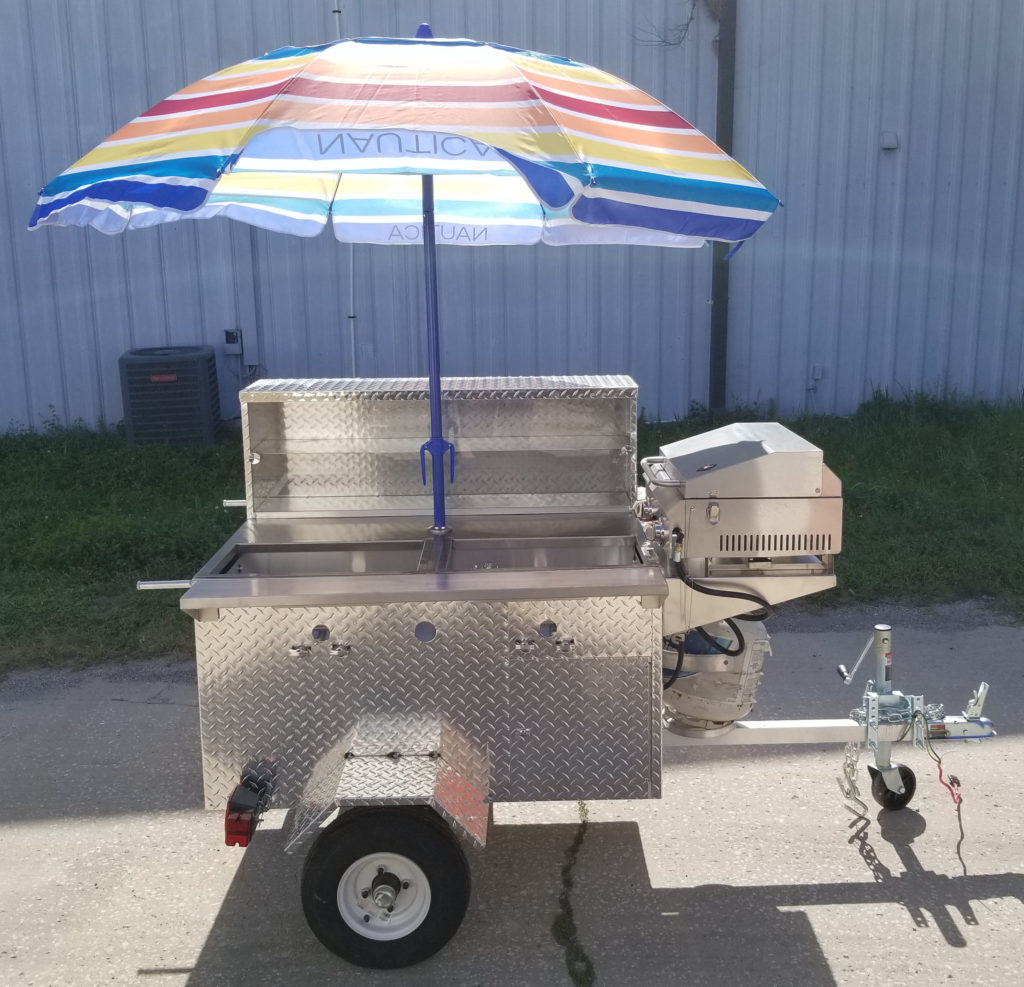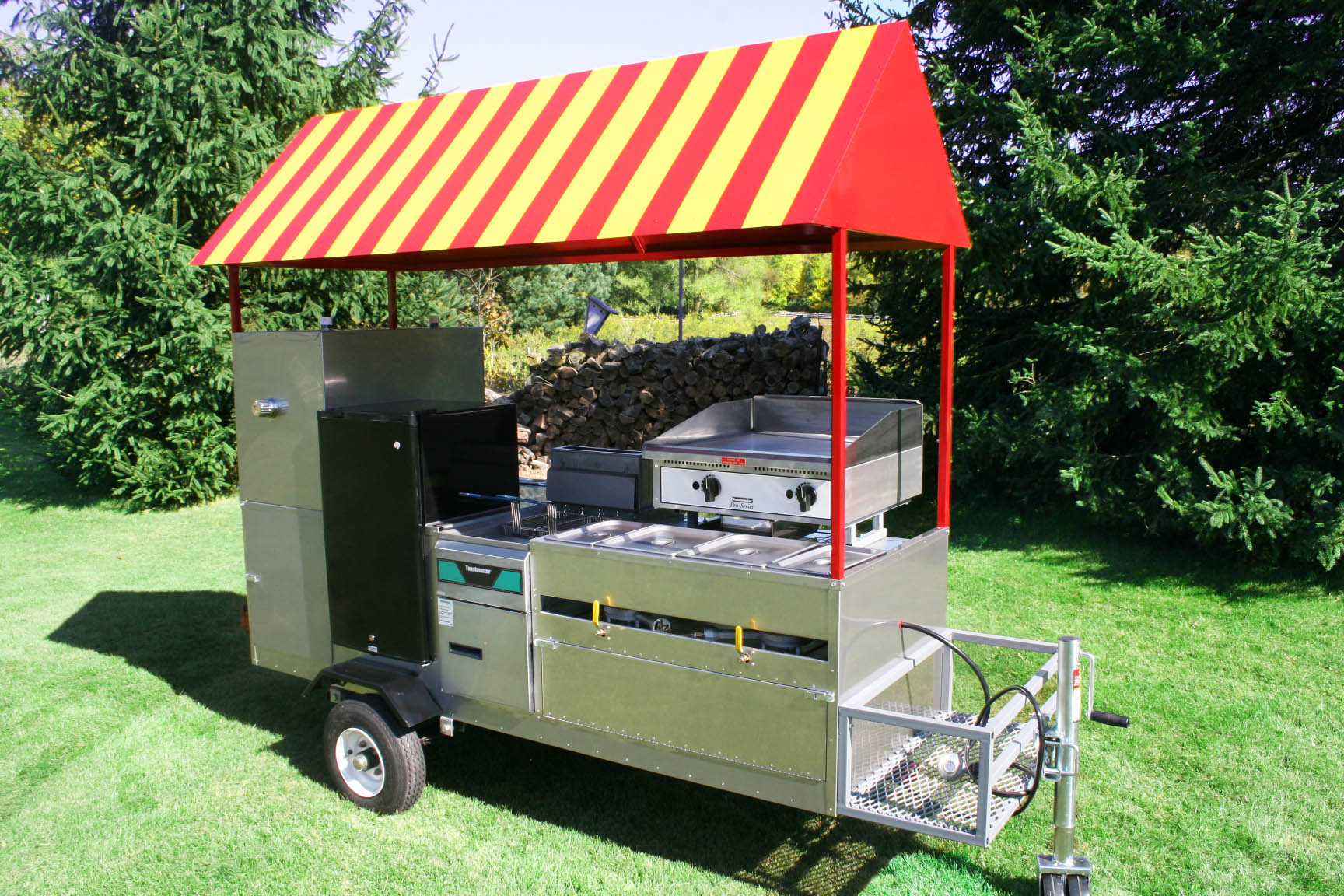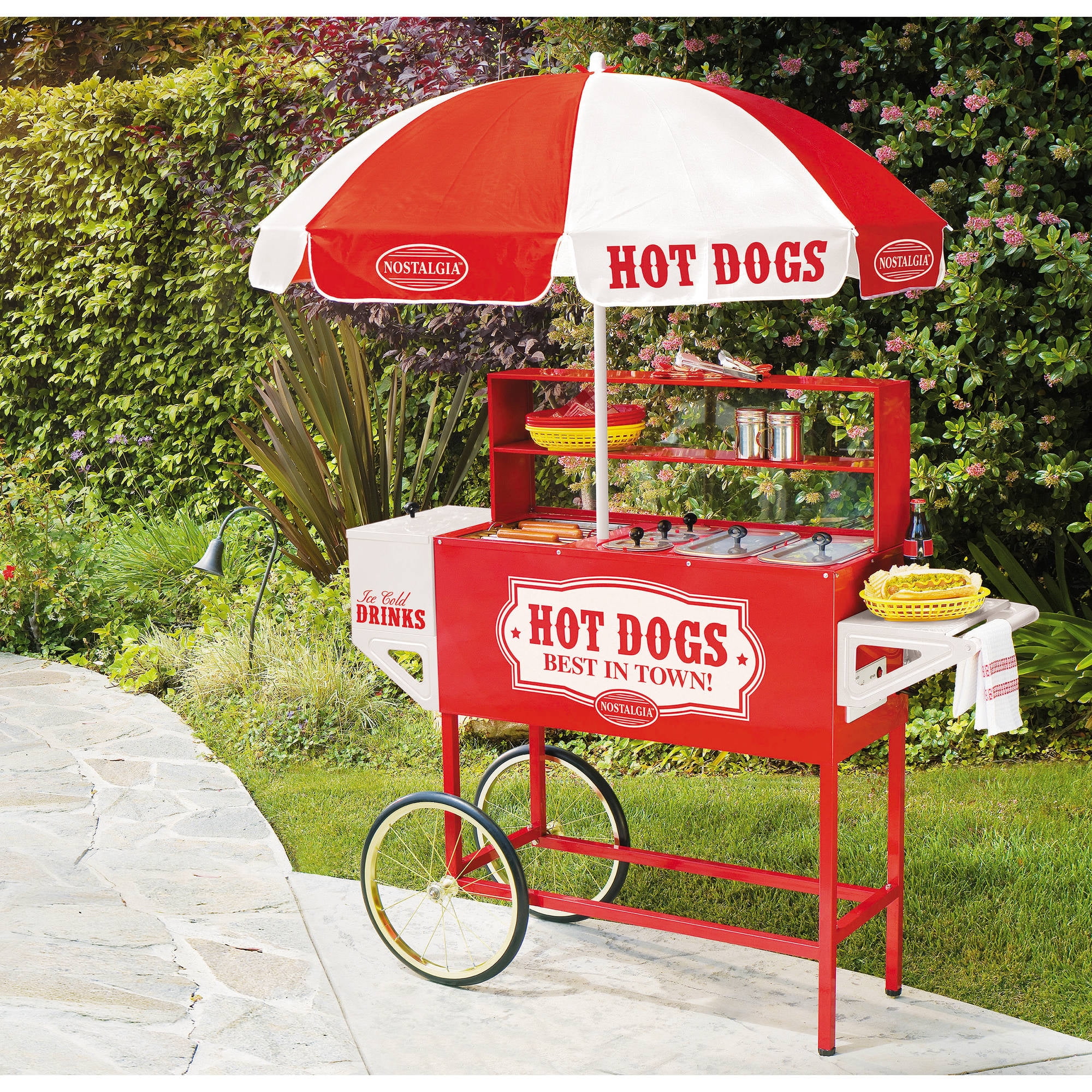The hotdog food cart stands as a testament to the culinary ingenuity that thrives in the heart of our cities. It is a melting pot of flavors, a symphony of aromas, and a testament to the entrepreneurial spirit that drives so many.
In this guide, we will delve into the world of hotdog food carts, exploring the intricacies of their operation and the strategies that can lead to their success. From menu design to marketing and promotion, we will provide you with the tools and insights you need to embark on your own hotdog food cart journey.
Target Audience
Hotdog food carts typically cater to a diverse range of individuals who seek convenient and affordable meals.
Their target audience primarily comprises:
Age
- Young adults (18-34): Students, young professionals, and individuals seeking quick and inexpensive meals.
- Families with children: Parents looking for budget-friendly options for feeding their families.
Gender
- No significant gender bias; hotdogs appeal to both men and women.
Income
- Individuals with low to moderate incomes: Hotdogs offer a cost-effective meal option.
Lifestyle
- Busy individuals: Those with limited time or access to home-cooked meals.
- Event attendees: Hotdog carts are common at festivals, sporting events, and other gatherings.
Menu Design

Creating a comprehensive and enticing menu is crucial for the success of any food cart. A well-designed menu should not only showcase the available food items but also effectively convey the brand’s identity and values.
When designing a menu for a hotdog food cart, it is important to consider the following factors:
- Target Audience:The menu should cater to the specific preferences and dietary needs of the target audience.
- Variety:Offer a diverse range of hotdogs, toppings, and sides to appeal to a wide range of tastes.
- Pricing:Determine the pricing strategy for each item based on market research and cost analysis.
- Visual Appeal:The menu should be visually appealing and easy to read, using clear fonts, images, and colors.
Sample Menu, Hotdog food cart
Here is a sample menu for a hotdog food cart:
Hotdogs
- Classic Hotdog:Grilled hotdog on a toasted bun with mustard and relish ($3.00)
- Chicago-Style Hotdog:Grilled hotdog on a poppy seed bun with yellow mustard, neon green sweet pickle relish, chopped white onions, a dill pickle spear, tomato slices or wedges, pickled sport peppers, and a dash of celery salt ($4.50)
- Sonoran Hotdog:Grilled hotdog wrapped in bacon and topped with pinto beans, chopped onions, tomatoes, and mayonnaise ($5.00)
- Gourmet Hotdog:Grilled hotdog on a brioche bun with your choice of toppings (additional $0.50 per topping)
Toppings
- Mustard
- Relish
- Ketchup
- Mayonnaise
- Chopped onions
- Sauerkraut
- Jalapeños
- Bacon bits
- Cheese sauce
Sides
- French fries ($2.50)
- Onion rings ($3.00)
- Coleslaw ($1.50)
- Potato salad ($2.00)
Pricing Strategy
The pricing strategy for each item should be based on a combination of factors, including:
- Cost of ingredients:Determine the cost of the ingredients used to prepare each item.
- Market research:Conduct research to determine the average prices of similar items in the local market.
- Target audience:Consider the income level and spending habits of the target audience.
- Profit margin:Set prices that allow for a reasonable profit margin to cover operating costs and generate income.
By carefully considering these factors, food cart owners can develop a menu that is both appealing to customers and profitable for the business.
Location and Setup
Selecting the ideal location for your hotdog food cart is crucial for its success. Consider areas with high foot traffic, such as busy streets, shopping malls, or near popular attractions. Visibility is also key, so choose a spot where your cart is easily noticeable to potential customers.
When designing the layout of your cart, prioritize efficiency and customer flow. Organize your equipment and supplies strategically to minimize wait times and maximize productivity. Create a clear ordering area, a designated pickup window, and ample space for customers to line up without obstructing pedestrian traffic.
Foot Traffic and Visibility
- Identify areas with a steady flow of potential customers, such as near office buildings, schools, or public transportation hubs.
- Choose a location with good visibility, ensuring your cart is easily spotted from a distance.
- Consider the time of day and week when foot traffic is highest to maximize your potential customer base.
Competition and Regulations
- Research the local food cart scene to identify potential competition and avoid areas with too many similar vendors.
- Familiarize yourself with local regulations regarding food cart operation, including licensing, health inspections, and parking restrictions.
- Consider partnering with nearby businesses or property owners to secure a designated spot for your cart.
Cart Layout and Efficiency
- Organize your equipment and supplies in a logical order to streamline the ordering and preparation process.
- Create a dedicated ordering area with clear signage and a visible menu to facilitate customer decision-making.
- Establish a separate pickup window to minimize congestion and ensure a smooth customer experience.
Marketing and Promotion: Hotdog Food Cart
To attract customers and build a loyal clientele, a comprehensive marketing plan is crucial.
Social media platforms, local advertising, and word-of-mouth marketing can effectively reach the target audience and promote the food cart.
Social Media Marketing
- Create engaging content showcasing the menu, special offers, and customer testimonials.
- Utilize social media advertising to target specific demographics and interests.
- Run contests and giveaways to generate excitement and increase engagement.
Local Advertising
- Advertise in local newspapers, magazines, and online directories.
- Partner with local businesses and offer cross-promotions.
- Distribute flyers and posters in high-traffic areas.
Word-of-Mouth Marketing
- Provide excellent customer service to create a positive dining experience.
- Encourage customers to leave reviews on online platforms.
- Offer incentives for customer referrals.
Loyalty Program
To foster repeat business, a loyalty program can be implemented.
- Offer discounts, free items, or exclusive perks to loyal customers.
- Track customer purchases and reward them based on frequency or spending amount.
- Use a mobile app or loyalty card to make participation convenient.
Operations and Staffing
The daily operations of a hotdog food cart involve several key aspects, including food preparation, customer service, and cleanup. To ensure smooth and efficient operations, it is essential to establish clear procedures and allocate the necessary staff size and roles.
The size of the staff will depend on the volume of business and the complexity of the menu. Generally, a small cart with a limited menu may require only one or two staff members, while a larger cart with a more extensive menu may need three or more staff members.
Staff Roles
- Food Preparation:Responsible for preparing and cooking the hotdogs, as well as assembling and packaging orders.
- Customer Service:Responsible for taking orders, processing payments, and providing excellent customer service.
- Cleanup:Responsible for maintaining the cleanliness of the cart, including cleaning equipment, wiping down surfaces, and disposing of waste.
Procedures
Establishing clear procedures for food preparation, customer service, and cleanup is crucial for maintaining consistency and efficiency.
Food Preparation
- Follow all food safety regulations and guidelines.
- Maintain proper temperatures for food storage and cooking.
- Prepare hotdogs according to established recipes and quality standards.
- Assemble and package orders accurately and promptly.
Customer Service
- Greet customers warmly and professionally.
- Take orders accurately and efficiently.
- Process payments promptly and accurately.
- Provide excellent customer service, including addressing any concerns or requests.
Cleanup
- Clean equipment and surfaces regularly throughout the day.
- Dispose of waste properly and maintain a clean work area.
- Conduct a thorough cleanup at the end of each day.
By following these procedures and allocating the necessary staff size and roles, hotdog food cart operators can ensure smooth and efficient operations, providing customers with a positive and enjoyable dining experience.
Equipment and Supplies

Equipping a hotdog food cart requires a careful selection of essential equipment and supplies to ensure efficient and sanitary food preparation.
The core equipment includes grills for cooking hotdogs, refrigerators for storing ingredients, condiment dispensers for toppings, and cleaning supplies for maintaining hygiene.
Grills
- Choose grills that evenly distribute heat and can accommodate the desired number of hotdogs.
- Consider grills with adjustable temperature controls to suit different cooking needs.
Refrigerators
- Refrigerators are essential for storing perishable ingredients like hotdogs, buns, and condiments.
- Select refrigerators with adequate capacity and temperature control to maintain food safety.
Condiment Dispensers
- Condiment dispensers keep toppings like ketchup, mustard, relish, and onions organized and easily accessible.
- Choose dispensers that are durable, easy to clean, and prevent contamination.
Cleaning Supplies
- Maintaining a clean and sanitary work environment is crucial for food safety.
- Stock up on cleaning supplies like sponges, cloths, detergents, and sanitizers.
Maintenance and Cleaning Schedule
Regular maintenance and cleaning are vital for the longevity and hygiene of the equipment.
- Clean grills daily to prevent grease buildup and ensure even cooking.
- Sanitize refrigerators regularly to eliminate bacteria and maintain food safety.
- Clean condiment dispensers thoroughly after each use to prevent cross-contamination.
Financial Planning
A sound financial plan is essential for the success of any business, including a hotdog food cart. This plan should Artikel the startup costs, operating expenses, and potential revenue, as well as determine the profitability and return on investment.
To estimate the startup costs, consider the following expenses:
- Food cart: $5,000-$15,000
- Equipment (grill, steamer, etc.): $2,000-$5,000
- Supplies (hot dogs, buns, condiments, etc.): $1,000-$2,000
- Permits and licenses: $500-$1,000
- Marketing and promotion: $500-$1,000
The operating expenses will vary depending on the location and size of the food cart, but some common expenses include:
- Rent or lease: $500-$2,000 per month
- Utilities: $200-$500 per month
- Food and supplies: $1,000-$2,000 per month
- Labor: $1,000-$2,000 per month
- Insurance: $200-$500 per month
The potential revenue will depend on the number of hot dogs sold, the price of each hot dog, and the number of hours the food cart is open. A food cart that sells 100 hot dogs per day at $5 each, and is open for 8 hours per day, could generate $400 in revenue per day.
To determine the profitability, subtract the operating expenses from the potential revenue. In the example above, the food cart would have a profit of $200 per day. The return on investment can be calculated by dividing the profit by the startup costs.
In the example above, the food cart would have a return on investment of 4% per year.
Legal and Regulatory Considerations
It’s crucial to be aware of the legal and regulatory requirements involved in operating a hotdog food cart. Failure to comply can lead to fines, penalties, or even the closure of your business.
Obtaining Licenses and Permits
- Obtain a business license from the local authorities.
- Secure a food vendor permit from the health department.
- Ensure you have a valid driver’s license if your cart is mobile.
Compliance with Health and Safety Regulations
- Adhere to all health and safety regulations set by the local health department.
- Maintain a clean and sanitary work environment.
- Use proper food handling and storage techniques.
- Ensure all food is cooked to the proper temperature.
Sustainability

In the culinary world, adopting sustainable practices is not just a trend but a necessity. For a hotdog food cart, sustainability translates into minimizing environmental impact while maintaining operational efficiency. Implementing eco-friendly measures in food sourcing, waste management, and energy consumption not only benefits the environment but also aligns with the growing consumer demand for responsible businesses.
Food Sourcing
- Partner with local farmers and suppliers to reduce transportation emissions and support the local economy.
- Source ingredients from organic or sustainable farms to minimize pesticide and fertilizer use.
- Offer plant-based hotdog options to cater to vegetarian and vegan customers while reducing meat consumption.
Waste Management
- Implement a composting system for organic waste, such as vegetable scraps and paper napkins.
- Use biodegradable packaging materials for hotdogs, utensils, and condiments.
- Recycle all recyclable materials, including aluminum cans, plastic bottles, and cardboard.
Energy Consumption
- Use energy-efficient appliances, such as LED lighting and low-power refrigerators.
- Consider using solar panels to generate renewable energy for the cart.
- Unplug equipment when not in use to reduce standby power consumption.
Innovation and Trends
Innovate to stand out in the competitive food cart industry by exploring unique hotdog flavors, toppings, and cooking techniques. Stay abreast of emerging trends to cater to evolving customer preferences.
Unique Hotdog Flavors
- Create hotdogs infused with exotic spices, herbs, and ingredients, such as truffle oil, smoked paprika, or Thai chili peppers.
- Experiment with different meats, such as lamb, venison, or turkey, to cater to diverse dietary preferences.
Innovative Toppings
- Offer unconventional toppings that complement the hotdog’s flavors, such as kimchi slaw, pickled onions, or roasted pineapple salsa.
- Create signature sauces and condiments that enhance the overall taste experience.
Novel Cooking Techniques
- Experiment with different cooking methods, such as sous vide or reverse searing, to achieve optimal flavor and texture.
- Consider using specialty equipment, such as a hotdog roller or flat-top grill, to create unique textures and presentations.
Emerging Trends
Stay informed about emerging trends in the food cart industry to adapt to changing customer demands.
- Offer plant-based hotdog options to cater to the growing demand for vegetarian and vegan cuisine.
- Incorporate sustainable practices, such as using eco-friendly packaging and sourcing ingredients from local suppliers.
- Utilize technology, such as online ordering and mobile payments, to enhance customer convenience.
Questions and Answers
What are the key factors to consider when choosing a location for a hotdog food cart?
Foot traffic, visibility, competition, and proximity to potential customers are all crucial factors to consider when selecting a location for your hotdog food cart.
How can I develop a unique menu for my hotdog food cart?
Experiment with different hotdog flavors, toppings, and cooking techniques to create a menu that stands out from the competition. Consider offering signature dishes and seasonal specials to keep your customers engaged.
What marketing strategies are effective for promoting a hotdog food cart?
Utilize social media, local advertising, and word-of-mouth marketing to reach your target audience. Create a strong online presence, engage with your followers, and encourage customer reviews to build credibility and attract new patrons.
